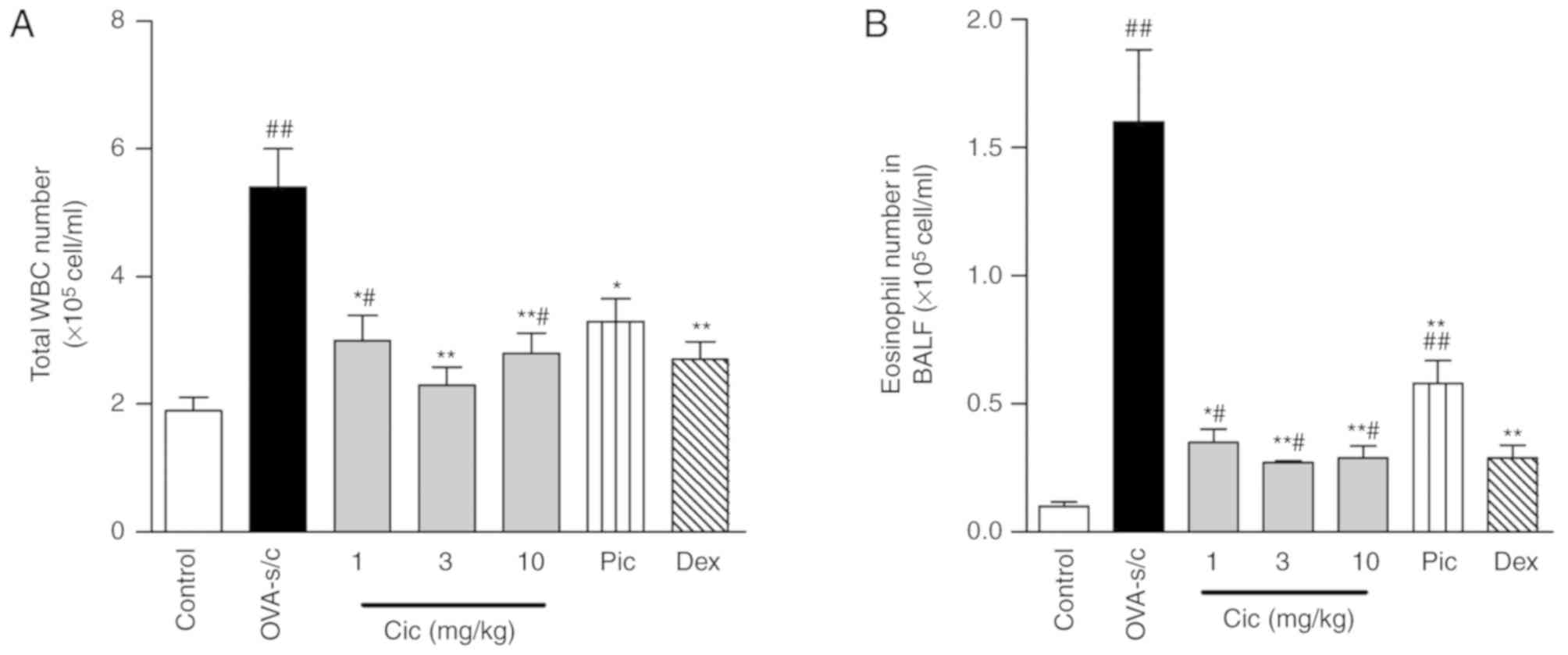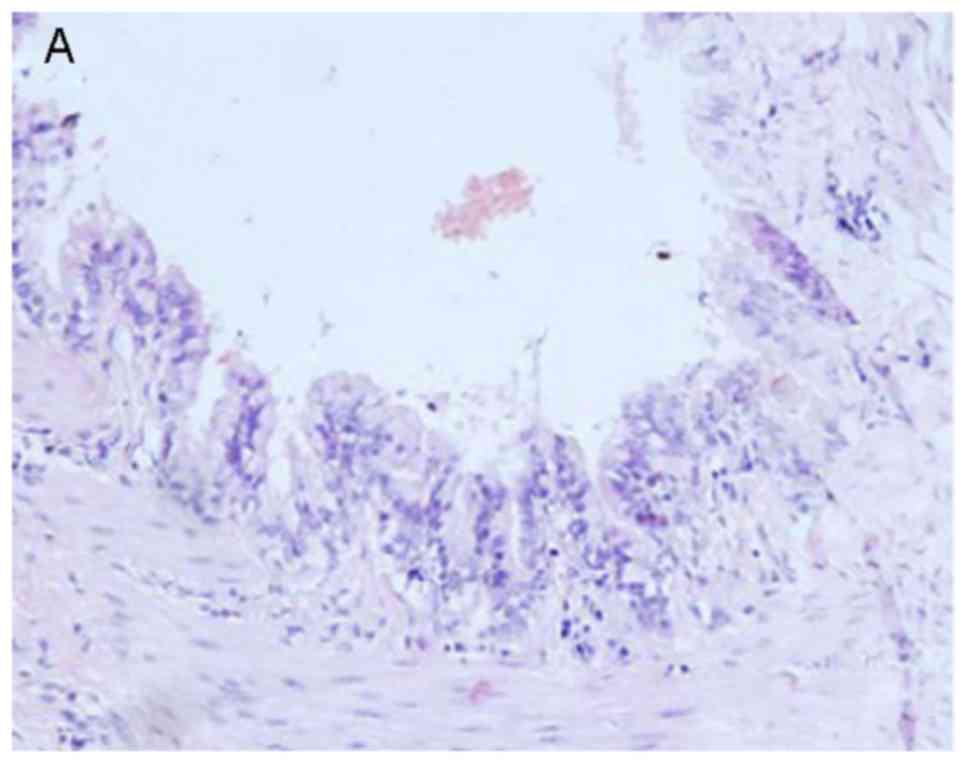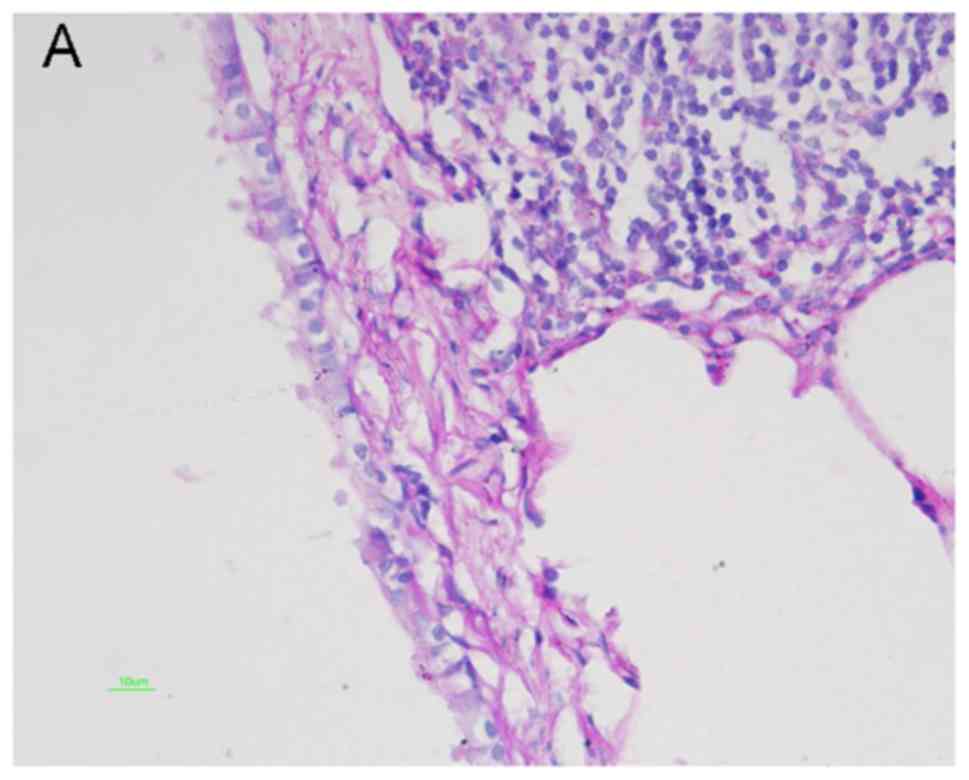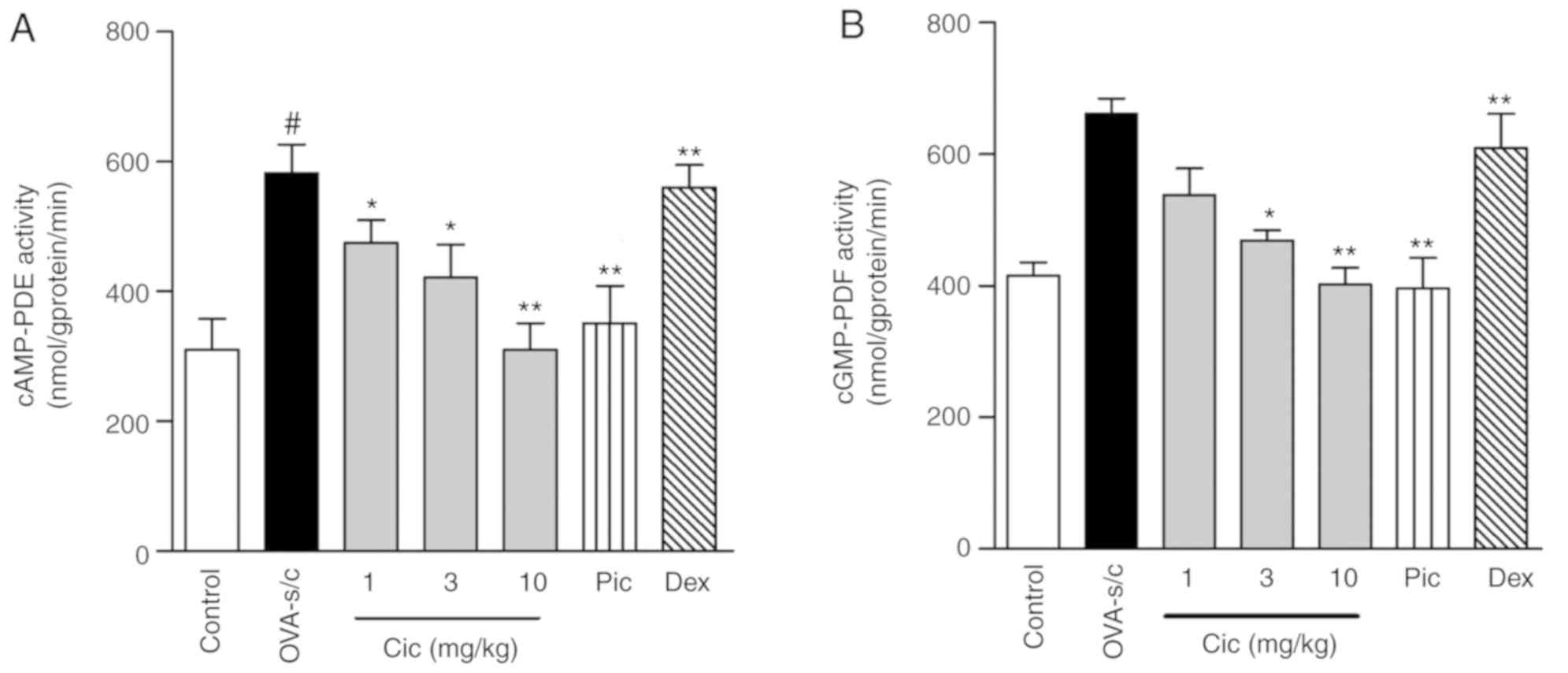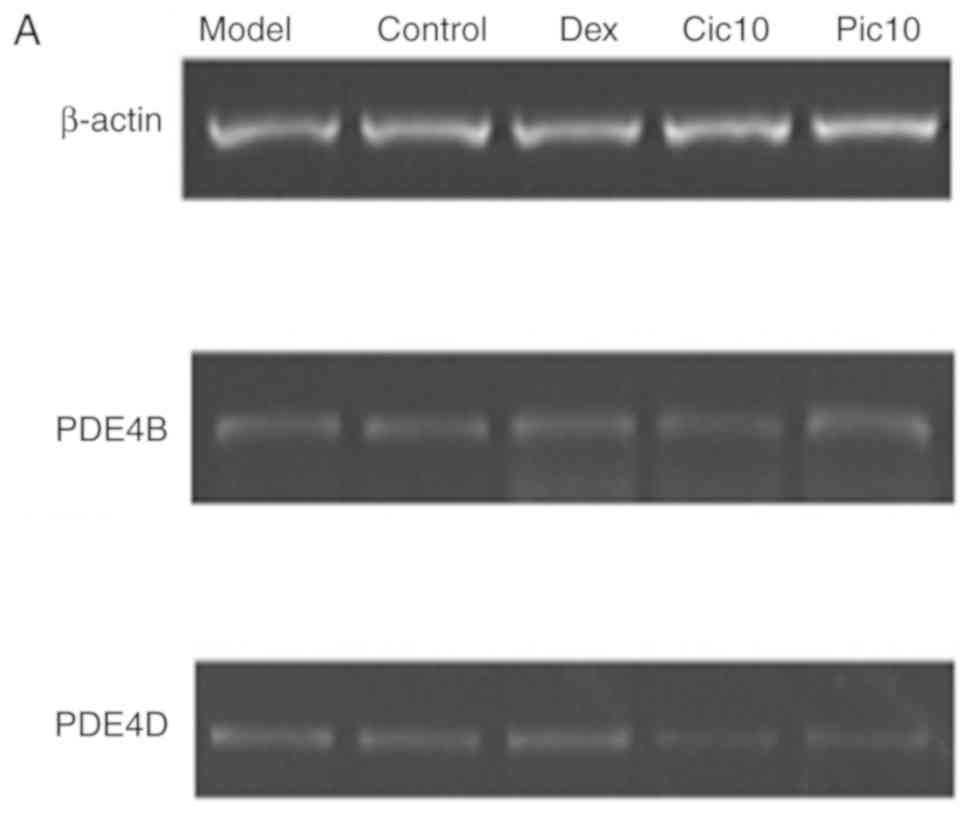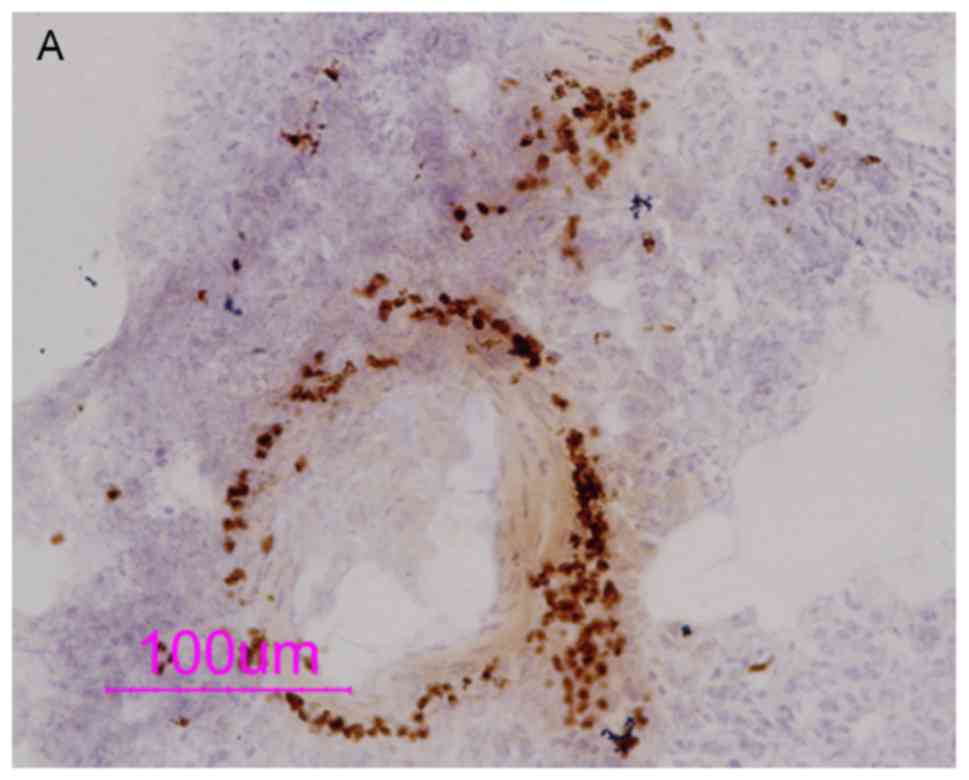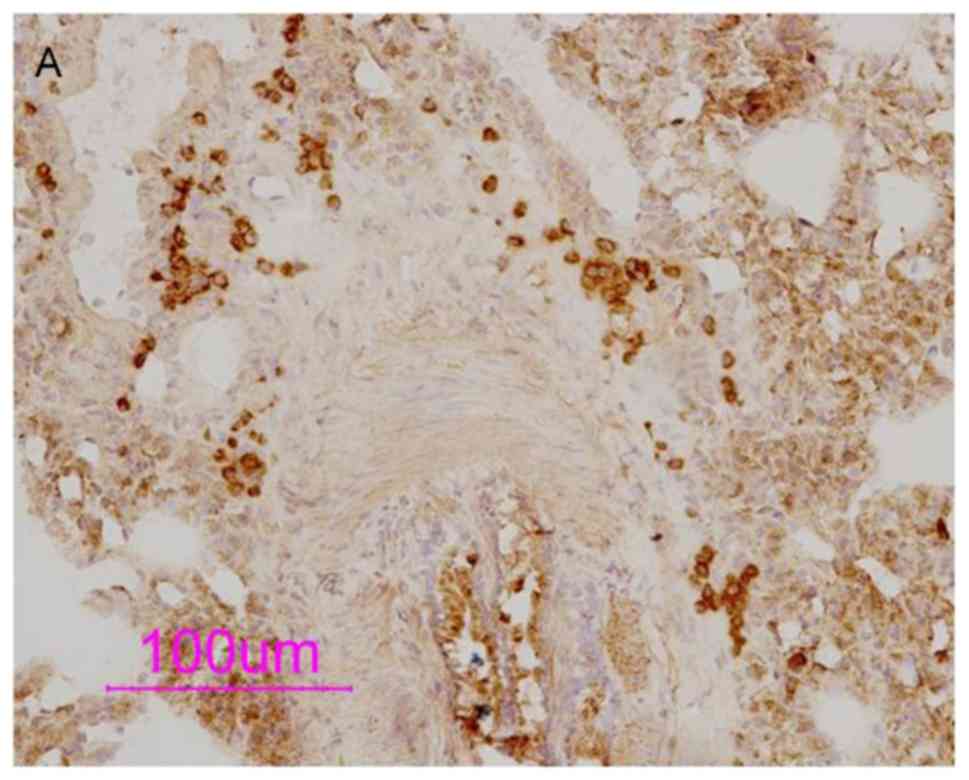Anti‑inflammatory effect of ciclamilast in an allergic model involving the expression of PDE4B
- Authors:
- Published online on: January 2, 2019 https://doi.org/10.3892/mmr.2019.9802
- Pages: 1728-1738
Abstract
Introduction
Cyclic nucleotide phosphodiesterases (PDEs) are a superfamily of enzymes that catalyze cAMP and cGMP intracellular secondary messengers and regulate a wide array of genes and proteins. Phosphodiesterase 4 (PDE4) is a member of a family of enzymes that selectively degrade intracellular cAMP by increasing levels of cAMP, and PDE4 inhibitors are used in the treatment of asthma, chronic obstructive pulmonary disease (COPD) and atopic dermatitis (1,2). Various isoforms of PDE4 have been shown to interact with other proteins and lipids, allowing specific isoforms to be targeted to distinct intracellular sites and signaling complexes within cells. Our previous study reported that ovalbumin (OVA) sensitization and challenge significantly increased the activity of PDE4 and mRNA expression of PDE4A, PDE4C and PDE4D in the lung of a rat model of allergic asthma, and rolipram significantly inhibited the upregulation of PDE4 (3). PDE4B is mainly expressed in neutrophils and monocytes and is essential in the lipopolysaccharide (LPS)-induced secretion of tumor necrosis factor (TNF-α) (4–6), whereas PDE4D has been shown to be associated with airway hyper-reactivity. Singh et al (7) reported that prenatal exposure to cigarette smoke affected airway reactivity by modulating levels of cAMP in the lung through changes in the activity of PDE4D, indicating the importance of altered PDE4 activity.
Ciclamilast [N-(3,5-dichloropyrid-4-yl)-3-cyclopentyl-oxy-4-methylbenzamid] is a novel PDE4 inhibitor and is structurally analogous to piclamilast (RP 73401). In terms of its side effects, our previous study reported that ciclamilast may be a superior PDE4 inhibitor with fewer gastrointestinal side effects than piclamilast (8), and oral administration of ciclamilast significantly improved lung function and reduced the secretion of cytokines, neutrophil infiltration and goblet cell hyperplasia in OVA-sensitized and challenged mice (9), however, there is no currently available data to compare the activity of ciclamilast to piclamilast in treating allergic lung inflammation.
To compare the activities of ciclamilast and piclamilast, and elucidate the possible biochemical basis for the superior activity of ciclamilast, the present study investigated the effects of ciclamilast on the activity and expression of PDE4 in the lung of an allergic rat model, and compared them with the effects of piclamilast and dexamethasone. In addition, the present study performed a systemic pharmacodynamic review of the novel PDE4 inhibitor ciclamilast in asthma.
Materials and methods
Sensitization and treatment
A total of 70 Male Sprague-Dawley rats (weight, 150–170 g; age, 5–6 weeks old), were purchased from the Laboratory Animal Center of Zhejiang University School of Medicine (Zhejiang, China), and were initially housed in a light-controlled (12-h light/dark cycle), humidity-controlled (50–60%) and temperature-controlled (22–25°C) room with free access to food and water. The animal experiments were approved by The Zhejiang Medical Laboratory Animal Administration Committee.
The rats were sensitized subcutaneously with an injection (1 ml) of a saline suspension containing 0.2% OVA (Sigma-Aldrich; Merck KGaA, Darmstadt, Germany) and 10% aluminum hydroxide into the footpad, neck, back, groin and abdomen on day 0. The rats were aerosolized with OVA (1% in saline) for 30 min every day between days 15 and 21 using a jet nebulizer (PARI GmbH, Starnberg, Germany) as previously described (3) and sacrificed on day 21. Control mice were aerosolized with an equal volume of saline. Ciclamilast and piclamilast were suspended in 1% hydroxyethylcellulose solution. Ciclamilast (1, 3 and 10 mg/kg/day, i.g.), piclamilast (10 mg/kg/day, i.g.), and dexamethasone (0.3 mg/kg/day, i.p.) were administered 30 min prior to OVA challenge between days 15 and 21. Negative (Sham) control rats were gavaged with vehicle (1% hydroxyethylcellulose solution). Ciclamilast and piclamilast were provided by Beijing Joinn Drug Research Center (Beijing, China) and the administered dosages were lower than the maximum tolerated dose of piclamilast and ciclamilast (up to 10 mg/kg in beagles).
Preparation of bronchoalveolar lavage fluid (BALF)
Following the final OVA challenge, the rats were anaesthetized with urethane (2 g/kg, i.p.) prior to being sacrificed. Their lungs were lavaged with D-Hanks' solution via a tracheal catheter. This process was repeated three times with a total volume of 5 ml D-Hanks', and the BALF recovery rate was >90%. Total cells counts were determined with a hemocytometer. Slides for differential cell counts were prepared by a centrifuge at 450 × g at 4°C for 10 min. The slides were stained with Wright's stain, and the total numbers of eosinophils/neutrophils, monocytes/macrophages and lymphocyte were recorded on each slide using an Olympus CH-20 light microscope (Olympus Corporation, Tokyo, Japan; magnification, ×400), followed by calculation of the percent and absolute number.
Histological examination
The lungs were immersed in 4% neutral formalin for 7 days and then used to prepare paraffin blocks. The slides were prepared at a thickness of 8-µM and then stained with alcian blue-periodic acid-Schiff for measuring goblet cell hyperplasia and with hematoxylin and eosin (H&E) for examining cell infiltration and tissue lesions using an Olympus CH-20 light microscope (Olympus Corporation; magnification, ×400). For semi-quantified assessment of goblet cell hyperplasia, which reflects the extent of mucus production in the airway epithelium, the numbers of goblet cells in at least three different fields of each lung section were recorded. The mean scores were obtained from six rats. For semi-quantified assessment of pulmonary histological changes, eosinophil influx, edema and epithelial lesions were divided into five grades (10): 0, normal; 1, rare; 2, mild; 3, moderate; 4, severe. The score was recorded from at least three different fields of each lung section. The mean scores were obtained from six animals. Histopathological assessment was performed in a blinded-manner on randomized sections.
Assay for PDE activity
The lung lobes were harvested, and 10% homogenates were prepared using a homogenizer (JiangShu HaiMeng QiLin Medical Instrument Factory, Haimeng, China) in ice-cold hypotonic homogenization buffer (30 mmol/l HEPES, pH 7.4, 1 mmol/l EDTA, 1 mmol/l β-mercaptoethanol, 2 mmol/l PMSF and 10 g/l pepstatin A, 0.1% Triton X-100) and centrifuged (Eppendorf Centrifuge 5804R, Eppendorf, Hamburg, Germany) at 1, 2000 × g for 30 min at 4°C. The supernatants were collected and stored at −80°C until assaying the activity of PDE. Assays of cAMP-PDE and cGMP-PDE activity have been described in detail in our previous study (3).
Analysis of PDE4B and PDE4D mRNAs
Total RNA was isolated from each tissue using TRIzol® Reagent (Invitrogen; Thermo Fisher Scientific, Inc.), preparation of first-strand cDNA from rat was performed using First-strand cDNA Synthesis kit (Shanghai Sangon Biological Engineering Technology and Service, Shanghai, China). Reverse transcription was performed under the following conditions: Denaturation (70°C for 5 min), annealing (42°C for 60 min) and elongation (70°C for 10 min). The sequences of the polymerase chain reaction (PCR) primers used for PDE4B and PDE4D were as reported previously (9) and presented in Table I. The PCR primer sets were able to detect all known variants derived from the appropriate PDE4B and PDE4D genes. PCR amplification was performed in a standard PCR buffer [10 mM Tris-HCl, pH 9.0, 100 mM KCl, 80 mM (NH4)2SO4 and 0.1% NP-40] containing 0.2 mM of each dNTP, 1.5 mM of MgCl2, 500 nM of each primer and 1 unit of Taq DNA polymerase in a total volume of 25 µl for 30 cycles, with the following cycle parameters: Denaturing, 94°C for 45 sec; annealing, 58°C for 70 sec; and extension, 72°C for 2 min. Following PCR amplification, 8 µl each reaction mixture was resolved by electrophoresis on a 1.5% agarose gel containing ethidium bromide, and the PCR product bands were quantified by using a UVP Gel Documentation system (UVP LLC, Upland, CA, USA). The levels of PDE4 mRNAs were calculated relative to β-actin. It was confirmed that, under these conditions, the PCR product accumulation did not reach plateau levels.
PDE4B and PDE4D immunohistochemical (IHC) staining
The right lower lung lobes were collected intact, and the fresh lung tissues were snap-frozen in liquid nitrogen prior to being stored in frozen blocks at −80°C. When cut into sections, the lung tissues were embedded in the OCT compound in cryomolds, and serial 8-µm-thick sections were prepared on a cryostat (Leica CM1900; Leica Microsystems, Inc., Buffalo Grove, IL, USA) and then mounted on glass slides pretreated with 1% polylysine. The slides were then dried at room temperature for 5 min and fixed in ice-cold acetone for 10 min prior to being stored at −80°C until required. In double-step immunohistochemical staining, the slides were first incubated in 3% H2O2 in methanol for 10–15 min at room temperature to block any endogenous peroxidase activity and then incubated with PDE4B-specific antibody (cat. no. PD4-201AP; 1:2,000; FabGennix International, Inc., Frisco, TX, USA) and PDE4D-specific antibody (cat. no. PD4-401AP; 1:2,000; FabGennix International, Inc.) at 4°C overnight. Following three rinses in PBS, the sections were then incubated with ready-to-use peroxidase-conjugated secondary antibody rabbit anti-rat immunoglobulin G (IgG; cat. no. E046801; 1:500; Dako; Agilent Technologies, Inc., Santa Clara, CA, USA) for 30 min at room temperature. Following three rinses with PBS, the sections were incubated with diaminobenzidine tetrahydrochloride (cat. no. K346811; Dako; Agilent Technologies, Inc.) solution at room temperature for 2–8 min. The samples were then counterstained with Mayer's hematoxylin at room temperature for 1 min, and the slides were dehydrated and mounted. In each case, a serial H&E-stained section was examined for orientation and the histological diagnosis was confirmed using an Olympus CH-20 light microscope (Olympus Corporation; magnification, ×400).
Western blot analysis of PDE4B and PDE4D
To determine the protein levels of PDE4B and PDE4D, whole protein was extracted from the lung. The proteins were extracted by radioimmunoprecipitation assay buffer (Wuhan Boster Biological Technology, Ltd., Wuhan, China) containing 1× PhosSTOP (Roche Diagnostics, Basel, Switzerland), 1% protease inhibitor cocktail (Roche Diagnostics) and 2% phenylmethylsulfonyl fluoride (Wuhan Boster Biological Technology, Ltd.) The protein concentration was determined by the Bio-Rad Protein Assay kit (Bio-Rad Laboratories, Inc., Hercules, CA, USA). Subsequently, 100 µg total protein was loaded into each lane and proteins were separated by 10% SDS-PAGE gel and transferred onto polyvinylidene fluoride membranes (EMD Millipore, Billerica, MA, USA) using an electrophoresis system (Bio-Rad Laboratories, Inc.). The membranes were blocked at room temperature for 1 h with blocking solution, which was composed of 5% milk prepared in TBS/Tween 20, and subsequently incubated overnight at 4°C with the PDE4B-specific antibody (cat. no. PD4-201AP; 1:1,500; FabGennix International, Inc.) and PDE4D-specific antibody (cat. no. PD4-401AP; 1:500; FabGennix International, Inc.). The membranes were washed with TBST and incubated for 1 h at room temperature with the secondary antibody, horseradish peroxidase-linked anti-rabbit IgG (cat. no. E046801; 1:500; Dako; Agilent Technologies, Inc.), which was prepared in blocking solution (1:2,000). Following washing, the membrane was processed with a chemiluminescent kit (Santa Cruz Biotechnology, Inc., Santa Cruz, CA, USA) and subsequently exposed to X-ray film (XK-1; Kodak, Rochester, NY, USA). Detection of β-actin (cat. no. sc-47778; 1:4,000; Santa Cruz Biotechnology, Inc.) served as a loading control. Quantification was performed using Labwork software (version 4.0; UVP, LLC).
Statistical analysis
Data are presented as the mean ± standard deviation. SPSS (version 12; SPSS, Inc., Chicago, IL, USA) was used for statistical analysis, and one-way analysis of variance followed by Dunnett's test was used to determine significant differences between the treatment groups. P<0.05 was considered to indicate a statistically significant difference.
Results
Ciclamilast decreases total cell number and eosinophil infiltration in the BALF
The total cell number and eosinophil number in the BALF were significantly increased in the model group. Daily administration of different doses of ciclamilast between day 15 (the first day of challenge with aerosol ovalbumin) and 21 (the final day of challenge) significantly reduced airway infiltration of the cells, which was indicated by the significant reduction in the number of total cells and eosinophils. In particular, at a dose of 3 mg/kg, there was significant suppression. Piclamilast at a dose of 10 mg/kg significantly affected the total cell number in the BALF, but only marginally decreased the number of eosinophils. Dexamethasone at a dose of 0.3 mg/kg significantly decreased the total cell number and eosinophil number and had a similar potency to ciclamilast at 10 mg/kg (Fig. 1A and B).
Ciclamilast suppresses eosinophil infiltration and mucus production in the lung
Marked eosinophilic infiltration was observed around the airways and blood vessels in the model group compared with the control group (Fig. 2A and B). Dexamethasone significantly inhibited the infiltration of inflammatory cells compared with that in the model (Fig. 2C). Treatments with 10 mg/kg ciclamilast markedly attenuated the OVA-induced inflammatory alterations and the epithelial lesions compared with the untreated OVA model (Fig. 2D). Treatment with piclamilast (10 mg/kg) did not attenuate the OVA-induced epithelial lesions; however, it was effective in preventing eosinophil infiltration (Fig. 2E). In contrast, ciclamilast at a dose of 1 or 3 mg/kg was able to inhibit the inflammatory alterations and the epithelial lesions in the wall of small and large bronchioles (Fig. 2F). The number of goblet cells containing acid (purple) and neutral (magenta) mucins were increased in the OVA model group compared with control group (Fig. 3A and B), and dexamethasone significantly inhibited mucus secretion compared with the OVA model (Fig. 3C). The effect of ciclamilast was similar with dexamethasone (Fig. 3D). However, treatment with piclamilast (10 mg/kg) did not affect goblet cell hyperplasia (Fig. 3E). Compared with ciclamilast, dexamethasone exhibited an increased effectiveness on OVA-induced mucus secretion (Fig. 3F).
Ciclamilast decreases the allergen-induced upregulation of PDE activity in the lungs of allergic rats
To determine the effect of ciclamilast on the allergen-induced increase of PDE activity, the activities of cAMP-PDE and cGMP-PDE in the lung were examined. The activity of cAMP-PDE in the lung of the model rat was significantly elevated, resulting in an almost 1.5-fold higher activity than that of the normal rats (Fig. 4A). The activity of cGMP-PDE was also increased, however, the change was not significant (Fig. 4B). Our previous study showed that the increase in total cAMP-PDE activity by OVA sensitization and challenge may be caused primarily by the upregulation of PDE4 (3). In the present study, treatment with ciclamilast (1, 3 and 10 mg/kg) significantly reduced the activity of cAMP-PDE in a dose-dependent manner (ID50=0.2 mg/kg; Fig. 4A). Piclamilast 10 mg/kg and dexamethasone 0.3 mg/kg fully inhibited the increase in cAMP-PDE activity induced by OVA sensitization and OVA challenge (P<0.01). Of note, ciclamilast, piclamilast and dexamethasone also significantly decreased the activity of cGMP-PDE (Fig. 4B). At the same dosage of 10 mg/kg, ciclamilast was more effective than piclamilast at altering cAMP-PDE activity, but was weaker than piclamilast at altering cGMP-PDE activity. These results suggested that ciclamilast may have higher selectivity towards PDE4 compared with piclamilast. In addition, dexamethasone appeared to be as effective as either PDE4 inhibitor, inhibiting the activity of both cAMP-PDE and cGMP-PDE.
Ciclamilast downregulates the allergen-induced mRNA expression of PDE4B and PDE4D in lung tissues
Previous comparative studies have suggested that the mRNA expression of PDE4A, PDE4B, PDE4C and PDE4D in several toxicologically relevant tissues and blood leukocytes are significantly higher in rats than in humans, and the higher expression levels of PDE4 are correlated with a higher level of enzyme activity in rat leukocytes (11). Our previous study confirmed that the mRNA expression levels of PDE4A, PDE 4C and PDE 4D were upregulated in the lung from the rat model of allergic lung inflammation, whereas there was no effect on the mRNA expression of PDE4B (3). To clarify the effect of ciclamilast on PDE subtype, the present study determined the subtype expression in lung tissues. The results showed that the model rats had significantly higher mRNA levels of PDE4D (~2-fold) than the control rats, but not of PDE4B (Fig. 5A and B). These results are consistent with our earlier study. Treatment with ciclamilast at 1, 3 and 10 mg/kg, respectively, inhibited PDE4D-specific mRNA expression by 61.8, 52.6 and 57.9% (P<0.01, some data not shown) compared with that in the model group. Of note, ciclamilast at 10 mg/kg also inhibited PDE4B-specific mRNA expression by 27% (P<0.05). However, piclamilast at 10 mg/kg inhibited PDE4D-specific mRNA expression by 62% (P<0.01) but had no effect on PDE4B. Dexamethasone also inhibited the mRNA expression of PDE4B and PDE4D by 23 and 34%, respectively; however, the difference in the expression levels PDE4B was not significant.
Negative feedback regulation of the allergen-induced protein expression of PDE4B and PDE4D by ciclamilast
To determine the distribution of the PDE4 subtype, IHC staining was used to detect the expression of PDE4 isoforms. The results showed abundant expression of PDE4B and PDE4D in inflammatory cells around the blood vessels and airway (Figs. 6 and 7). OVA sensitization and challenge caused an increase in the protein expression of PDE4B and PDE4D in eosinophils in contrast to the H&E-stained slides (P<0.05). PDE4B was mainly distributed in the cytoplasm, whereas PDE4D was mainly distributed in the cell membrane. The different distribution of PDE4 subtypes indicates different functions of the PDE4 subtypes.
The protein expression of PDE4B in the eosinophils of the OVA-sensitization and -challenged group was significantly enhanced, suggesting that the combination of OVA sensitization and OVA challenge is likely to upregulate the expression of PDE4B. Ciclamilast increased the expression of the PDE4B (P<0.05), whereas piclamilast did not. This result suggests that ciclamilast exhibits higher selectivity towards PDE4B than piclamilast.
PDE4D is mainly expressed in airway smooth muscle, vascular smooth muscle, airway epithelial cells and the membrane of inflammatory cells. In the bronchial epithelial cells, tracheal smooth muscle cells and vascular smooth muscle cells of the model group, OVA-sensitization without OVA challenge group, and OVA-challenge without OVA sensitization group, the expression of PDE4D was significantly enhanced, indicating that challenge following OVA sensitization, or challenge or sensitization alone increased the expression of PDE4D, and ciclamilast inhibited this increased expression. Although piclamilast also inhibited the increased expression of PDE4D in the OVA-induced bronchial epithelial cells, it did not inhibit expression in the OVA-induced tracheal smooth muscle or vascular smooth muscle cells, in which the expression of PDE4D was increased. This result indicated that piclamilast had higher selectivity towards PDE4D than ciclamilast. The expression of PDE4B/4D was decreased by treatment with dexamethasone (P<0.05), mainly due to decreased numbers of eosinophils.
Discussion
Asthma is characterized by airway inflammation, tissue injury and remodeling, bronchoconstriction and mucus hypersecretion, involving multiple tissues including leukocytes from the circulating blood, airway sensory neurons, smooth muscle cells and epithelial cells. Numerous preclinical in vivo studies have shown that PDE4 inhibitors suppress characteristic features of these diseases, including cell recruitment, activation of inflammatory cells and physiological changes in lung function (12). Therefore, if PDE4 is involved in the pathogenesis of asthma, lung PDE4 may be as important as, if not more important than, leukocyte PDE4. Various PDE4 subtypes are known to be expressed in different tissues and have distinct biological roles. For example, 4B, but not 4D, is the predominant PDE4 subtype in monocytes and neutrophils (4,5), involved in the regulation of TNF production (13). As a novel anti-inflammatory therapy, PDE4 inhibitors have been developed for asthma and chronic obstructive pulmonary disease COPD since the 1980s. Since 2010, the first PDE4 inhibitor, roflumilast (Daxas®) has been marketed in the European Union and Canada for the treatment of severe COPD. In the majority of cases, problems in the clinical development of PDE4 inhibitors are due to a lack of efficacy or a low tolerated dose (14). Therefore, the development of newer PDE4 inhibitors to overcome this limitation has been encouraged (14,15).
In terms of piclamilast (RP 73401), various studies have investigated its anti-inflammatory and bronchodilator properties since 1994 (16–23). Recent evidence shows that piclamilast prolonged the survival of pre-term rat pups with neonatal hyperoxic lung injury by inhibiting inflammation and reducing alveolar fibrin deposition (24), and further investigation found that piclamilast attenuated and partially reversed pulmonary hypertension and right ventricular hypertrophy, but did not affect advanced alveolar development in neonatal rats with hyperoxia-induced lung injury or affect normal lung and heart development (25). Piclamilast also attenuated the respiratory burst of sputum cells from patients with mild asthma and COPD in vitro (22).
There have been various reports on the potency of piclamilast, rolipram and roflumilast, including our previous studies and those of others (Table II). There is conflicting evidence regarding the potency of piclamilast and rolipram, including effects on LPS-induced circulating TNF-α (26). It has been demonstrated that RP 73401 and rolipram exert the same potency on the inhibition of antigen- and mediator-induced bronchospasms in guinea pigs (27), and relaxation of the tracheae pre-contracted with histamines (28). However, Bundschuh et al (29) reported that roflumilast exhibited effects that were 8- and 25-fold higher than those of piclamilast and rolipram, respectively, in suppressing allergen-induced early airway reactions. Conflicting evidence has also been found for TNFα release, for example, Souness et al (26) demonstrated that RP 73401 (IC50: 6.9±3.3 nM, n=5) exhibited 71-fold higher potency than (±)-rolipram (IC50: 490±260 nM, n=4) at inhibiting LPS-induced TNFα release from human peripheral blood monocytes, and Wollin et al (30) reported that rolipram exhibited more potent inhibition of OVA-induced TNF-α release than piclamilast (9,31,32). Our previous studies in OVA-induced allergic mice or rats also support the hypothesis that rolipram has higher selectivity than piclamilast. Other reports also support these results (28,30). The reasons for the contradictory results may be due to the sources of the drug.
Table II.Pharmacological characteristics of ciclamilast and piclamilast on the ovalbumin-induced allergic model. |
In the present study, the anti-inflammatory effect of ciclamilast, a derivative of piclamilast, was reported. Ciclamilast exhibited more potent inhibition of cAMP-PDE activity, airway hyperresponsiveness, tracheae contraction and lung inflammation than piclamilast. Our previous comparative study showed that ciclamilast exhibited more potent bronchorelaxant effects than piclamilast on resting tension in a guinea pig airway smooth muscle model (32). Our previous study also showed that the IC50 values of piclamilast and rolipram on recombinant PDE4A expressed in GL62 yeast cells were 66.4 (33.3–132.2) and 3.73 (2.51–5.53) µmol/l, respectively (33), suggesting that rolipram had improved selectivity towards PDE4A than piclamilast.
By contrast, in lung tissues, PDE4D, but not PDE4B, is the dominant PDE4 subtype, with a critical role in the control of airway smooth muscle contraction (7). However, major PDE4 subtypes regulating the functions of airway sensory and epithelial cells remain to be elucidated. Individual PDE4 subtypes are non-redundant overall but are complementary. Based on their upregulation in the lungs of allergic rats, PDE4A and PDE4C, as with 4B and 4D, may also be involved in the pathogenesis of asthma in distinct tissues (3). In the present study, the effects of ciclamilast on lung PDE4 activity, PDE4 subtype expression, inflammation and mucus secretion were investigated in an asthmatic rat model. In this model, antigen sensitization and repeated challenges induced airway inflammation, airway goblet cell hyperplasia, and increases in the enzyme activity of cAMP-PDE and expression of PDE4B and PDE4D. These changes were suppressed by ciclamilast, piclamilast, roliparm and dexamethasone. Ciclamilast showed more potent inhibition of the mRNA expression of PDE4B than piclamilast. However, piclamilast showed more potent inhibition of PDE4D. According to the PDE activity assay, ciclamilast exhibited more potent selectivity towards cAMP-PDE, whereas piclamilast exhibited more potent selectivity towards cGMP-PDE. Furthermore, there was a correlation between the activity of cAMP-PDE and eosinophils in the BALF (Spearman's correlation coefficient=0.314, P<0.01) and lung tissue (Spearman's correlation coefficient=0.407, P<0.01). These data suggest that ciclamilast exerts a superior anti-inflammatory effect, which involves cAMP-PDE activity, mainly via PDE4B.
A previous study suggested that human primary CD4 (+) T cells expressed PDE4A, PDE4B and PDE4D in response to anti-CD3/CD28 stimulation in a time-dependent manner. The knockdown of either PDE4B or PDE4D inhibited the release of interleukin-2, similar to the effect of the panPDE4 inhibitor, RP 73401 (piclamilast) (21). PDE4D-targeting small interfering RNA alone was as effective as the panPDE4 inhibitor RP 73401 (piclamilast) (21). This result also supported the findings of the present study. While rolipram reversed the permeability of rat pulmonary microvascular endothelial cells, the mechanism may involve the downregulated mRNA expression of PDE4D (34). Jin et al (13) reported that mice deficient in PDE4B and PDE4D did not develop airway hyper-responsiveness, and the ablation of PDE4D had no impact on airway inflammation. These finding suggest the essential role of PDE4B in the development of allergen-induced airway inflammation, highlighting the fact that PDE4 inhibitors with PDE4B selectivity may have efficacy in asthma treatment.
In the present study, the inhibitory effects of dexamethasone on the mRNA expression of PDE4 subtypes in the lung suggest that glucocorticoids may also directly downregulate PDE4 activity, at least partly by downregulating the expression of PDE4. There is evidence suggesting that dexamethasone treatment can affect the cAMP signaling pathway in human osteosarcoma cells by decreasing the mRNA levels of the PDE4A and PDE4B subtypes, particularly the PDE4A4 and PDE4B1 isoforms (35). The dexamethasone-induced elevation of intracellular cAMP may represent one way by which glucocorticoids can modulate the immune response. PDE4 inhibitors may also be useful as an alternative or adjunctive treatment for glucocorticoid resistance or insensitivity in common inflammatory diseases, including asthma, rheumatoid arthritis, inflammatory bowel disease, COPD and acute respiratory distress syndrome, as they can reverse glucocorticoid resistance by inhibiting its underlying mechanisms in a variety of in vivo models (36,37). Furthermore, PDE4 inhibitor has been shown to be of use during therapy with glucocorticoids in cases of leukemia (38,39).
In conclusion, the present study showed that ciclamilast exhibited more potent inhibition of cAMP-PDE activity and lung inflammation than piclamilast. The main reason may be due to its improved selectivity towards PDE4B rather than PDE4D, and improved selectivity towards cAMP-PDE rather than cGMP-PDE. These results provide overall insights into the mechanism of action of ciclamilast as an anti-inflammatory agent and a suggest that PDE4 inhibitors with PDE4B selectivity may have efficacy in asthma treatment.
Acknowledgements
The authors would like to thank the Beijing Joinn Drug Research Center (Beijing, China) for supplying ciclamilast and piclamilast. In addition, the authors would like to thank Professor Cong-lin Zuo from Beijing Joinn Drug Research Center for providing the toxicological data of ciclamilast.
Funding
The present study was supported by grants (grant nos. LY18H310002 and LY14H310004) from Zhejiang Provincial Natural Science Foundation, grants (grant nos. 81570056 and 81170536) from the Natural Science Foundation of China, a grant (grant no. 2014A01) from the Health Science & Technology Program of Hangzhou and a grant (grant no. 2017C37132) from Fund project of Zhejiang provincial science and Technology Department.
Availability of data and materials
The datasets used or analyzed during the current study are available from the corresponding author on reasonable request.
Authors' contributions
XYZ, QMX, JQC and HFT designed the study and wrote the manuscript. XYZ and JCC prepared the ovalbumin model and harvested the lung samples, analyzed the polymerase chain reaction, western blotting and histology results. All authors read and approved the final manuscript.
Ethics approval and consent to participate
The animal experiments were approved by the Zhejiang Medical Laboratory Animal Administration Committee.
Patient consent for publication
Not applicable.
Competing interests
The authors declare that they have no competing interests.
References
|
Shu SJ, Lei XG, Liang JH, Song YH, Xu Q, Chen XD, Mao LG and Li ZG: The effects of second messenger cAMP and its relative components on the contraction of uterine smooth muscle of rat. Eur Rev Med Pharmacol Sci. 21:1709–1721. 2017.PubMed/NCBI | |
|
Sakkas LI, Mavropoulos A and Bogdanos DP: Phosphodiesterase 4 inhibitors in immune-mediated diseases: Mode of action, clinical applications, current and future perspectives. Curr Med Chem. 24:3054–3067. 2017. View Article : Google Scholar : PubMed/NCBI | |
|
Tang HF, Song YH, Chen JC, Chen JQ and Wang P: Upregulation of phosphodiesterase-4 in the lung of allergic rats. Am J Respir Crit Care Med. 71:823–828. 2005. View Article : Google Scholar | |
|
Ma D, Wu P, Egan RW, Billah MM and Wang P: Phosphodiesterase 4B gene transcription is activated by lipopolysaccharide and inhibited by interleukin-10 in human monocytes. Mol Pharmacol. 55:50–57. 1999. View Article : Google Scholar : PubMed/NCBI | |
|
Wang P, Wu P, Ohleth KM, Egan RW and Billah MM: Phosphodiesterase 4B2 is the predominant phosphodiesterase species and undergoes differential regulation of gene expression in human monocytes and neutrophils. Mol Pharmacol. 56:170–174. 1999. View Article : Google Scholar : PubMed/NCBI | |
|
Jin SL and Conti M: Induction of the cyclic nucleotide phosphodiesterase PDE4B is essential for LPS-activated TNF-alpha responses. Proc Natl Acad Sci USA. 99:7628–7633. 2002. View Article : Google Scholar : PubMed/NCBI | |
|
Singh SP, Barrett EG, Kalra R, Razani-Boroujerdi S, Langley RJ, Kurup V, Tesfaigzi Y and Sopori ML: Prenatal cigarette smoke decreases lung cAMP and increases airway hyperresponsiveness. Am J Respir Crit Care Med. 168:342–347. 2003. View Article : Google Scholar : PubMed/NCBI | |
|
Deng YM, Xie QM, Tang HF, Sun JG, Deng JF, Chen JQ and Yang SY: Effects of ciclamilast, a new PDE 4 PDE4 inhibitor, on airway hyperresponsiveness, PDE4D expression and airway inflammation in a murine model of asthma. Eur J Pharmacol. 547:125–135. 2006. View Article : Google Scholar : PubMed/NCBI | |
|
Tang HF, Chen JQ, Xie QM, Zheng XY, Zhu YL, Adcock I and Wang X: The role of PDE4 in pulmonary inflammation and goblet cell hyperplasia in allergic rats. Biochim Biophys Acta 1762. 525–532. 2006. | |
|
Xie QM, Chen JQ, Shen WH and Bian RL: Correlative changes of interferon-gamma and interleukin-4 between cortical layer and pulmonary airway of sensitized rats. Acta Pharmacol Sin. 23:248–252. 2002.PubMed/NCBI | |
|
Bian H, Zhang J, Wu P, Varty LA, Jia Y, Mayhood T, Hey JA and Wang P: Differential type 4 cAMP-specific phosphodiesterase (PDE4) expression and functional sensitivity to PDE4 inhibitors among rats, monkeys and humans. Biochem Pharmacol. 68:2229–2236. 2004. View Article : Google Scholar : PubMed/NCBI | |
|
Spina D: PDE4 inhibitors: Current status. Br J Pharmacol. 155:308–315. 2008. View Article : Google Scholar : PubMed/NCBI | |
|
Jin SL, Goya S, Nakae S, Wang D, Bruss M, Hou C, Umetsu D and Conti M: Phosphodiesterase 4B is essential for T(H)2-cell function and development of airway hyperresponsiveness in allergic asthma. J Allergy Clin Immunol. 126:1252–1259.e12. 2010. View Article : Google Scholar : PubMed/NCBI | |
|
Giembycz MA and Newton R: Harnessing the clinical efficacy of phosphodiesterase 4 inhibitors in inflammatory lung diseases: Dual-selective phosphodiesterase inhibitors and novel combination therapies. Handb Exp Pharmacol. 415–446. 2011. View Article : Google Scholar : PubMed/NCBI | |
|
Giembycz MA: Can the anti-inflammatory potential of PDE4 inhibitors be realized: Guarded optimism or wishful thinking? Br J Pharmacol. 155:288–290. 2008. View Article : Google Scholar : PubMed/NCBI | |
|
Ashton MJ, Cook DC, Fenton G, Karlsson JA, Palfreyman MN, Raeburn D, Ratcliffe AJ, Souness JE, Thurairatnam S and Vicker N: Selective type IV phosphodiesterase inhibitors as antiasthmatic agents. The syntheses and biological activities of 3-(cyclopentyloxy)-4-methoxybenzamides and analogues. J Med Chem. 37:1696–1703. 1994. View Article : Google Scholar : PubMed/NCBI | |
|
Souness JE, Maslen C, Webber S, Foster M, Raeburn D, Palfreyman MN, Ashton MJ and Karlsson JA: Suppression of eosinophil function by RP 73401, a potent and selective inhibitor of cyclic AMP-specific phosphodiesterase: Comparison with rolipram. Br J Pharmacol. 115:39–46. 1995. View Article : Google Scholar : PubMed/NCBI | |
|
Cooper N, Teixeira MM, Warneck J, Miotla JM, Wills RE, Macari DM, Gristwood RW and Hellewell PG: A comparison of the inhibitory activity of PDE4 inhibitors on leukocyte PDE4 activity in vitro and eosinophil trafficking in vivo. Br J Pharmacol. 126:1863–1871. 1999. View Article : Google Scholar : PubMed/NCBI | |
|
Favot L, Keravis T and Lugnier C: Modulation of VEGF-induced endothelial cell cycle protein expression through cyclic AMP hydrolysis by PDE2 and PDE4. Thromb Haemost. 92:634–645. 2004. View Article : Google Scholar : PubMed/NCBI | |
|
Favot L, Keravis T, Holl V, Le Bec A and Lugnier C: VEGF-induced HUVEC migration and proliferation are decreased by PDE2 and PDE4 inhibitors. Thromb Haemost. 90:334–343. 2003. View Article : Google Scholar : PubMed/NCBI | |
|
Peter D, Jin SL, Conti M, Hatzelmann A and Zitt C: Differential expression and function of phosphodiesterase 4 (PDE4) subtypes in human primary CD4+ T cells: Predominant role of PDE4D. J Immunol. 178:4820–4831. 2007. View Article : Google Scholar : PubMed/NCBI | |
|
Beeh KM, Beier J, Lerch C, Schulz AK and Buhl R: Effects of piclamilast, a selective phosphodiesterase-4 inhibitor, on oxidative burst of sputum cells from mild asthmatics and stable COPD patients. Lung. 182:369–377. 2004. View Article : Google Scholar : PubMed/NCBI | |
|
Aoki M, Kobayashi M, Ishikawa J, Saita Y, Terai Y, Takayama K, Miyata K and Yamada T: A novel phosphodiesterase type 4 inhibitor, YM976 (4-(3-chlorophenyl)-1,7-diethylpyrido[2,3-d]pyrimidin-2(1H)-one), with little emetogenic activity. J Pharmacol Exp Ther. 295:255–260. 2000.PubMed/NCBI | |
|
de Visser YP, Walther FJ, Laghmani EH, van Wijngaarden S, Nieuwland K and Wagenaar GT: Phosphodiesterase-4 inhibition attenuates pulmonary inflammation in neonatal lung injury. Eur Respir J. 31:633–644. 2008. View Article : Google Scholar : PubMed/NCBI | |
|
de Visser YP, Walther FJ, Laghmani el H, Steendijk P, Middeldorp M, van der Laarse A and Wagenaar GT: Phosphodiesterase 4 inhibition attenuates persistent heart and lung injury by neonatal hyperoxia in rats. Am J Physiol Lung Cell Mol Physiol. 302:L56–L67. 2012. View Article : Google Scholar : PubMed/NCBI | |
|
Souness JE, Griffin M, Maslen C, Ebsworth K, Scott LC, Pollock K, Palfreyman MN and Karlsson JA: Evidence that cyclic AMP phosphodiesterase inhibitors suppress TNF alpha generation from human monocytes by interacting with a ‘low-affinity’ phosphodiesterase 4 conformer. Br J Pharmacol. 118:649–658. 1996. View Article : Google Scholar : PubMed/NCBI | |
|
Raeburn D, Underwood SL, Lewis SA, Woodman VR, Battram CH, Tomkinson A, Sharma S, Jordan R, Souness JE, Webber SE and Karlsson JA: Anti-inflammatory and bronchodilator properties of RP 73401, a novel and selective phosphodiesterase type IV inhibitor. Br J Pharmacol. 113:1423–1431. 1994. View Article : Google Scholar : PubMed/NCBI | |
|
Holbrook M, Gozzard N, James T, Higgs G and Hughes B: Inhibition of bronchospasm and ozone-induced airway hyperresponsiveness in the guinea-pig by CDP840, a novel phosphodiesterase type 4 inhibitor. Br J Pharmacol. 118:1192–1200. 1996. View Article : Google Scholar : PubMed/NCBI | |
|
Bundschuh DS, Eltze M, Barsig J, Wollin L, Hatzelmann A and Beume R: In vivo efficacy in airway disease models of roflumilast, a novel orally active PDE4 inhibitor. J Pharmacol Exp Ther. 297:280–290. 2001.PubMed/NCBI | |
|
Wollin L, Bundschuh DS, Wohlsen A, Marx D and Beume R: Inhibition of airway hyperresponsiveness and pulmonary inflammation by roflumilast and other PDE4 inhibitors. Pulm Pharmacol Ther. 19:343–352. 2006. View Article : Google Scholar : PubMed/NCBI | |
|
Sun JG, Deng YM, Wu X, Tang HF, Deng JF, Chen JQ, Yang SY and Xie QM: Inhibition of phosphodiesterase activity, airway inflammation and hyperresponsiveness by PDE4 inhibitor and glucocorticoid in a murine model of allergic asthma. Life Sci. 79:2077–2085. 2006. View Article : Google Scholar : PubMed/NCBI | |
|
Ji H, Xie QM and Chen JQ: Comparison of piclamilast with ciclamilast in bronchodilating and antiallergic effects. Zhejiang Da Xue Xue Bao Yi Xue Ban. 32:274–278. 2003.(In Chinese). PubMed/NCBI | |
|
Chen JC, Chen JQ, Xie QM and Zhu YL: Selective inhibition of purified human phosphodiesterase 4A expressed in yeast cell GL62 by ciclamilast, piclamilast, and rolipram. Acta Pharmacol Sin. 25:1171–1175. 2004.PubMed/NCBI | |
|
Thompson WJ, Ashikaga T, Kelly JJ, Liu L, Zhu B, Vemavarapu L and Strada SJ: Regulation of cyclic AMP in rat pulmonary microvascular endothelial cells by rolipram-sensitive cyclic AMP phosphodiesterase (PDE4). Biochem Pharmacol. 63:797–807. 2002. View Article : Google Scholar : PubMed/NCBI | |
|
Ahlstrom M, Pekkinen M, Huttunen M and Lamberg-Allardt C: Dexamethasone down-regulates cAMP-phosphodiesterase in human osteosarcoma cells. Biochem Pharmacol. 69:267–275. 2005. View Article : Google Scholar : PubMed/NCBI | |
|
Barnes PJ and Adcock IM: Glucocorticoid resistance in inflammatory diseases. Lancet. 373:1905–1917. 2009. View Article : Google Scholar : PubMed/NCBI | |
|
Milara J, Navarro A, Almudever P, Lluch J, Morcillo EJ and Cortijo J: Oxidative stress-induced glucocorticoid resistance is prevented by dual PDE3/PDE4 inhibition in human alveolar macrophages. Clin Exp Allergy. 41:535–546. 2011. View Article : Google Scholar : PubMed/NCBI | |
|
Tiwari S, Dong H, Kim EJ, Weintraub L, Epstein PM and Lerner A: Type 4 cAMP phosphodiesterase (PDE4) inhibitors augment glucocorticoid-mediated apoptosis in B cell chronic lymphocytic leukemia (B-CLL) in the absence of exogenous adenylyl cyclase stimulation. Biochem Pharmacol. 69:473–483. 2005. View Article : Google Scholar : PubMed/NCBI | |
|
Dong H, Zitt C, Auriga C, Hatzelmann A and Epstein PM: Inhibition of PDE3, PDE4 and PDE7 potentiates glucocorticoid-induced apoptosis and overcomes glucocorticoid resistance in CEM T leukemic cells. Biochem Pharmacol. 79:321–329. 2010. View Article : Google Scholar : PubMed/NCBI |



